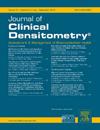类风湿性关节炎的 DXA 与心血管疾病:范围综述
IF 1.6
4区 医学
Q4 ENDOCRINOLOGY & METABOLISM
引用次数: 0
摘要
目前,DXA技术在世界许多地区得到广泛应用。越来越多的人认识到DXA不仅在骨质疏松症管理方面有价值,而且在运动医学、肌肉减少症、心血管疾病和死亡率评估方面也有价值。这些特征可能对糖尿病或类风湿关节炎等高危人群特别有意义。最近的系统综述和荟萃分析显示,DXA可以可靠地预测骨折、心血管疾病、痴呆和死亡率。类风湿性关节炎(RA)是一种慢性炎症性疾病,影响包括滑膜关节、骨骼和其他组织在内的多个器官。患类风湿性关节炎的人更容易发生骨质疏松性骨折、心血管疾病、感染和过早死亡,这是众所周知的。RA是FRAX等一些骨折风险算法中唯一包含的独特疾病,因此RA患者经常被推荐进行DXA扫描以评估其骨质疏松症的风险。我们之前的研究表明,在我们的RA人群中,椎体骨折、主动脉钙化和心血管疾病普遍存在,并有很强的相关性。在本文中,我们对Medline和Embase上发表的文献进行了范围综述,以更好地了解RA人群中DXA和心血管疾病的现状。在最初的检索中确定了822篇论文,其中7篇论文反映了来自7个不同国家的2038名RA患者。研究设计包括4个横断面、2个纵向和1个病例对照。所有研究都包括与各种心血管指标的关联,而只有1项研究将临床事件作为结果。我们的结果表明,这是一个相对未开发的领域,但具有重要的临床潜力。本文章由计算机程序翻译,如有差异,请以英文原文为准。
DXA and cardiovascular disease in rheumatoid arthritis: A scoping review
DXA technology is widely available today in many regions of the world. There is a growing realization of the value of DXA not only for osteoporosis management but also for sports medicine, sarcopenia, and the assessment of cardiovascular disease and mortality. Such features may be of particular interest for populations with a greater risk of these outcomes such as those with diabetes mellitus or rheumatoid arthritis. Recent systematic reviews and meta-analyses show DXA can robustly predict fractures, cardiovascular disease, dementia and mortality. Rheumatoid arthritis (RA) is a chronic inflammatory disease affecting multiple organs including synovial joints, bone and other tissues. People suffering from RA have a greater propensity to osteoporotic fracture, cardiovascular disease, infection and premature death, which is well recognised. RA is the only unique disease included in some fracture risk algorithms such as FRAX, and so RA patients are often referred for a DXA scan to evaluate their risk of osteoporosis. We have previously shown vertebral fractures, aortic calcification and cardiovascular disease are prevalent in our RA population, with strong association. In this paper we performed a scoping review of published literature in Medline and Embase to better understand the current status of DXA and cardiovascular disease in RA populations. 822 papers were identified in an initial search of which 7 papers reflecting 2,038 RA patients from 7 different countries were included. Study design included 4 cross-sectional, 2 longitudinal and 1 case-control. All included associations with various cardiovascular measures, while only 1 included clinical events as an outcome. Our results suggest this is an area which remains relatively unexplored but has substantial important clinical potential.
求助全文
通过发布文献求助,成功后即可免费获取论文全文。
去求助
来源期刊

Journal of Clinical Densitometry
医学-内分泌学与代谢
CiteScore
4.90
自引率
8.00%
发文量
92
审稿时长
90 days
期刊介绍:
The Journal is committed to serving ISCD''s mission - the education of heterogenous physician specialties and technologists who are involved in the clinical assessment of skeletal health. The focus of JCD is bone mass measurement, including epidemiology of bone mass, how drugs and diseases alter bone mass, new techniques and quality assurance in bone mass imaging technologies, and bone mass health/economics.
Combining high quality research and review articles with sound, practice-oriented advice, JCD meets the diverse diagnostic and management needs of radiologists, endocrinologists, nephrologists, rheumatologists, gynecologists, family physicians, internists, and technologists whose patients require diagnostic clinical densitometry for therapeutic management.
 求助内容:
求助内容: 应助结果提醒方式:
应助结果提醒方式:


